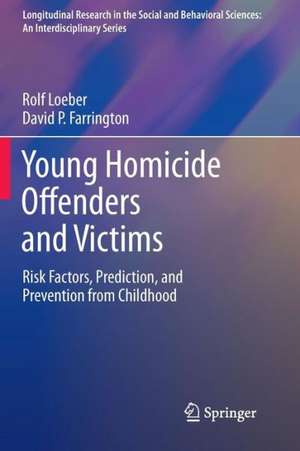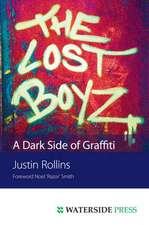Young Homicide Offenders and Victims: Risk Factors, Prediction, and Prevention from Childhood: Longitudinal Research in the Social and Behavioral Sciences: An Interdisciplinary Series
Autor Rolf Loeber, David P. Farringtonen Limba Engleză Paperback – 19 apr 2013
Based on the findings of a unique longitudinal study, Young Homicide Offenders and Victims: Risk Factors, Prediction, and Prevention from Childhood now provides experts with unprecedented analysis of prospectively collected data on 1,517 boys and young men who grew up in Pittsburgh, Pennsylvania. Following these males from childhood into early adulthood, examining their lives and the conditions under which they grew up in a representative mid-sized American city, the study forms the basis of this unique volume designed to stimulate debate on key questions of prevention and intervention as well as dispel popular myths about the childhood and adolescent features of homicide offenders and homicide victims.
Key areas of coverage include:
- Early childhood risk factors of young homicide offenders and victims.
- Insights into homicide offenders’ lives as told in their own words.
- The effectiveness of screening for at-risk youth.
- Risk factor–based prevention and intervention strategies.
- The impact of interventions on homicide rates.
- Policy implications at the local, state, and national levels.
-------
“This book changes the game in violence research … The analysis is masterful, the prose is readable, and the achievement is nothing short of stunning.”
Richard Rosenfeld, Ph.D. / Curators Professor of Criminology and Criminal Justice, University of Missouri-St. Louis
“This book will stand the test of time as a landmark homicide study.”
James C. Howell, Ph.D. / Senior Research Associate, National Gang Center
“This is a fascinating, pioneering book … The authors’ sophisticated analyses demonstrate convincingly the considerable value of prospective longitudinal data for enhancing our understanding of the etiology and control of lethal violence.”
Steven F. Messner, Ph.D. / Distinguished Teacher Professor, Department of Sociology, University at Albany, SUNY / President, American Society of Criminology
| Toate formatele și edițiile | Preț | Express |
|---|---|---|
| Paperback (1) | 636.80 lei 43-57 zile | |
| Springer Us – 19 apr 2013 | 636.80 lei 43-57 zile | |
| Hardback (1) | 643.00 lei 43-57 zile | |
| Springer Us – 2 aug 2011 | 643.00 lei 43-57 zile |
Preț: 636.80 lei
Preț vechi: 749.19 lei
-15% Nou
Puncte Express: 955
Preț estimativ în valută:
121.87€ • 126.76$ • 100.61£
121.87€ • 126.76$ • 100.61£
Carte tipărită la comandă
Livrare economică 14-28 aprilie
Preluare comenzi: 021 569.72.76
Specificații
ISBN-13: 9781461428237
ISBN-10: 1461428238
Pagini: 224
Ilustrații: XXII, 202 p.
Dimensiuni: 155 x 235 x 12 mm
Greutate: 0.32 kg
Ediția:2011
Editura: Springer Us
Colecția Springer
Seria Longitudinal Research in the Social and Behavioral Sciences: An Interdisciplinary Series
Locul publicării:New York, NY, United States
ISBN-10: 1461428238
Pagini: 224
Ilustrații: XXII, 202 p.
Dimensiuni: 155 x 235 x 12 mm
Greutate: 0.32 kg
Ediția:2011
Editura: Springer Us
Colecția Springer
Seria Longitudinal Research in the Social and Behavioral Sciences: An Interdisciplinary Series
Locul publicării:New York, NY, United States
Public țintă
ResearchCuprins
Foreword by Kathleen Heide.- Foreword by Irvin Waller.- Preface.- Young Male Homicide Offenders and Victims: Current Knowledge, Beliefs, and Key Questions.- The Pittsburgh Youth Study.- Homicide, Offenders, and Victims in the United States, Pennsylvania, Pittsburgh, and the Pittsburgh Youth Study.- Early Risk Factors for Convicted Homicide Offenders and Homicide Arrestees.- Prediction of Homicide Offenders out of Violent boys.- Early Risk Factors for Homicide Victims and Shooting Victims.- Homicide Offenders Speak.- Modeling the Impact of Preventive Interventions on the National Homicide Rate.- Modeling the Impact of Interventions on Local Indicators of Offending, Victimization and Incarceration.- Conclusions and Implications.
Recenzii
From the reviews:
"There is no doubt that the authors have elevated empirical research in this important area to a new and unprecedented level. This groundbreaking study should be read by all behavioral science and legal professionals concerned with understanding serious youth violence, as it will be the standard by which future research on this topic will and should be judged."
Charles Patrick Ewing
PsycCRITIQUES, April 11, 2012, Vol. 57, Release 15, Article 5
---------
“This is a fascinating, pioneering book. Based on results from the Pittsburgh Youth Study, it identifies childhood risk factors that predict involvement in homicide as offenders and victims, and it offers provocative simulations of the potential impacts of possible prevention strategies. The authors’ sophisticated analyses demonstrate convincingly the considerable value of prospective longitudinal data for enhancing our understanding of the etiology and control of lethal violence.”
Steven F. Messner, Ph.D.
Distinguished Teacher Professor, Department of Sociology, University at Albany, SUNY
President, American Society of Criminology
---------
“How do homicide offenders differ from other violent offenders with respect to early life and more proximate risk factors? How do homicide offenders differ from homicide victims? Is it possible to predict, years in advance, who will kill or be killed? Until now, homicide researchers could only speculate about the answers to these and related questions, or the answers were based on crude and often unreliable data. This book changes the game in violence research. Analyzing richly detailed data from a community sample of boys studied from early childhood into young adulthood, Loeber and Farrington dissect the developmental pathways that lead to lethal violence and propose interventions to ameliorate the early-life risk factors that otherwise lead predictably toviolence and death. The analysis is masterful, the prose is readable, and the achievement is nothing short of stunning. This book is required reading for veteran researchers, students, criminal justice and public health professionals, and anyone who wants to know what cutting edge research on a critical public problem looks like.”
Richard Rosenfeld, Ph.D.
Curators Professor of Criminology and Criminal Justice, University of Missouri-St. Louis
---------
“Beginning with Wolfgang’s classic Patterns in Criminal Homicide, many important books on homicide have followed but none has recently emerged as a turning point in the field. That is, until now. Loeber and Farrington’s volume is a collection of firsts in many respects, primarily because it is the first to use prospective longitudinal data to predict homicide offenders and victims from childhood risk factors as well as to consider prevention/intervention efforts in great detail. In very short order, Young Homicide Offenders and Victims: Development, Risk Factors, and Prediction from Childhood will become one of those key books that sits on the desks and shelves of students, academics, practitioners, and policy makers alike. But, unlike some others, this is one that will be read, reread, and learned from in many respects.
Alex R. Piquero, Ph.D.
Gordon P. Waldo Professor of Criminology
Florida State University
---------
“This book will stand the test of time as a landmark homicide study. Principally, it is the first of its kind to analyze the development of a representative sample of homicide offenders and victims over the life course, from childhood to adulthood. Moreover, the researchers are two of the most renowned developmental criminologists in the world.”
James C. Howell, Ph.D.
Senior Research Associate
National Gang Center
“Rolf Loeber, David Farrington, and their colleagues …describe how they used data from a large longitudinal study, the Pittsburgh Youth Study (PYS), to develop statistical models for predicting which young men would become violent offenders, convicted perpetrators of homicide, shooting victims, and victims of homicide. … This groundbreaking study should be read by all behavioral science and legal professionals concerned with understanding serious youth violence, as it will be the standard by which future research on this topic will and should be judged.” (Charles Patrick Ewing, PsycCRITIQUES, Vol. 57 (15), April, 2012)
"There is no doubt that the authors have elevated empirical research in this important area to a new and unprecedented level. This groundbreaking study should be read by all behavioral science and legal professionals concerned with understanding serious youth violence, as it will be the standard by which future research on this topic will and should be judged."
Charles Patrick Ewing
PsycCRITIQUES, April 11, 2012, Vol. 57, Release 15, Article 5
---------
“This is a fascinating, pioneering book. Based on results from the Pittsburgh Youth Study, it identifies childhood risk factors that predict involvement in homicide as offenders and victims, and it offers provocative simulations of the potential impacts of possible prevention strategies. The authors’ sophisticated analyses demonstrate convincingly the considerable value of prospective longitudinal data for enhancing our understanding of the etiology and control of lethal violence.”
Steven F. Messner, Ph.D.
Distinguished Teacher Professor, Department of Sociology, University at Albany, SUNY
President, American Society of Criminology
---------
“How do homicide offenders differ from other violent offenders with respect to early life and more proximate risk factors? How do homicide offenders differ from homicide victims? Is it possible to predict, years in advance, who will kill or be killed? Until now, homicide researchers could only speculate about the answers to these and related questions, or the answers were based on crude and often unreliable data. This book changes the game in violence research. Analyzing richly detailed data from a community sample of boys studied from early childhood into young adulthood, Loeber and Farrington dissect the developmental pathways that lead to lethal violence and propose interventions to ameliorate the early-life risk factors that otherwise lead predictably toviolence and death. The analysis is masterful, the prose is readable, and the achievement is nothing short of stunning. This book is required reading for veteran researchers, students, criminal justice and public health professionals, and anyone who wants to know what cutting edge research on a critical public problem looks like.”
Richard Rosenfeld, Ph.D.
Curators Professor of Criminology and Criminal Justice, University of Missouri-St. Louis
---------
“Beginning with Wolfgang’s classic Patterns in Criminal Homicide, many important books on homicide have followed but none has recently emerged as a turning point in the field. That is, until now. Loeber and Farrington’s volume is a collection of firsts in many respects, primarily because it is the first to use prospective longitudinal data to predict homicide offenders and victims from childhood risk factors as well as to consider prevention/intervention efforts in great detail. In very short order, Young Homicide Offenders and Victims: Development, Risk Factors, and Prediction from Childhood will become one of those key books that sits on the desks and shelves of students, academics, practitioners, and policy makers alike. But, unlike some others, this is one that will be read, reread, and learned from in many respects.
Alex R. Piquero, Ph.D.
Gordon P. Waldo Professor of Criminology
Florida State University
---------
“This book will stand the test of time as a landmark homicide study. Principally, it is the first of its kind to analyze the development of a representative sample of homicide offenders and victims over the life course, from childhood to adulthood. Moreover, the researchers are two of the most renowned developmental criminologists in the world.”
James C. Howell, Ph.D.
Senior Research Associate
National Gang Center
“Rolf Loeber, David Farrington, and their colleagues …describe how they used data from a large longitudinal study, the Pittsburgh Youth Study (PYS), to develop statistical models for predicting which young men would become violent offenders, convicted perpetrators of homicide, shooting victims, and victims of homicide. … This groundbreaking study should be read by all behavioral science and legal professionals concerned with understanding serious youth violence, as it will be the standard by which future research on this topic will and should be judged.” (Charles Patrick Ewing, PsycCRITIQUES, Vol. 57 (15), April, 2012)
Notă biografică
David P. Farrington, O.B.E., is Professor of Psychological Criminology at the Institute of Criminology, Cambridge University, and Adjunct Professor of Psychiatry at Western Psychiatric Institute and Clinic, University of Pittsburgh. He is co-chair of the U.S. National Institute of Justice Study Group on Transitions from Juvenile Delinquency to Adult Crime and co-chair of the U.S. Centers for Disease Control Expert Panel on Protective Factors against Youth Violence. His major research interest is in developmental criminology, and he is Director of the Cambridge Study in Delinquent Development, which is a prospective longitudinal survey of over 400 London males from age 8 to age 48. In addition to over 500 published journal articles and book chapters on criminological and psychological topics, he has published over 75 books, monographs and government publications.
Rolf Loeber is Professor of Psychiatry, Psychology, and Epidemiology at the Western Psychiatric Institute and Clinic, School of Medicine, University of Pittsburgh, and Professor of Juvenile Delinquency and Social Development, Free University, Amsterdam, Netherlands. He is Codirector of the Life History Program and is principal investigator of three longitudinal studies, the Pittsburgh Youth Study, the Developmental Trends Study, and the Pittsburgh Girls Study. He has published widely in the fields of juvenile antisocial behavior and delinquency, substance use, and mental health problems (more than 130 peer-reviewed papers and 90 book chapters and other papers).
Rolf Loeber is Professor of Psychiatry, Psychology, and Epidemiology at the Western Psychiatric Institute and Clinic, School of Medicine, University of Pittsburgh, and Professor of Juvenile Delinquency and Social Development, Free University, Amsterdam, Netherlands. He is Codirector of the Life History Program and is principal investigator of three longitudinal studies, the Pittsburgh Youth Study, the Developmental Trends Study, and the Pittsburgh Girls Study. He has published widely in the fields of juvenile antisocial behavior and delinquency, substance use, and mental health problems (more than 130 peer-reviewed papers and 90 book chapters and other papers).
Textul de pe ultima copertă
The first decade of the new century proved to be a deadly one for many children and young people in the United States. Despite increased policing on the streets, higher rates of incarceration, harsher sentencing, stricter control of illegal drugs, and attempts to reduce access to firearms, FBI reports show that more than 7,300 young people between the ages of 15 and 29 were murdered in 2008 alone. It’s clear that traditional crime reduction strategies have not stemmed the rising tide of homicides perpetrated by and upon one of society’s most vulnerable populations. Innovative, practicable solutions are needed to staunch this lethal trend.
Based on the findings of a unique longitudinal study, Young Homicide Offenders and Victims: Risk Factors, Prediction, and Prevention from Childhood now provides experts with unprecedented analysis of prospectively collected data on 1,517 boys and young men who grew up in Pittsburgh, Pennsylvania. Following these males from childhood into early adulthood, examining their lives and the conditions under which they grew up in a representative mid-sized American city, the study forms the basis of this unique volume designed to stimulate debate on key questions of prevention and intervention as well as dispel popular myths about the childhood and adolescent features of homicide offenders and homicide victims.
Key areas of coverage include:
-------
“This book changes the game in violence research … The analysis is masterful, the prose is readable, and the achievement is nothing short of stunning.”
Richard Rosenfeld, Ph.D. / Curators Professor of Criminology and Criminal Justice, University of Missouri-St. Louis
“This book will stand the test of time as a landmark homicide study.”
James C. Howell, Ph.D. / Senior Research Associate, National Gang Center
“This is a fascinating, pioneering book … The authors’ sophisticated analyses demonstrate convincingly the considerable value of prospective longitudinal data for enhancing our understanding of the etiology and control of lethal violence.”
Steven F. Messner, Ph.D. / Distinguished Teacher Professor, Department of Sociology, University at Albany, SUNY / President, American Society of Criminology
Based on the findings of a unique longitudinal study, Young Homicide Offenders and Victims: Risk Factors, Prediction, and Prevention from Childhood now provides experts with unprecedented analysis of prospectively collected data on 1,517 boys and young men who grew up in Pittsburgh, Pennsylvania. Following these males from childhood into early adulthood, examining their lives and the conditions under which they grew up in a representative mid-sized American city, the study forms the basis of this unique volume designed to stimulate debate on key questions of prevention and intervention as well as dispel popular myths about the childhood and adolescent features of homicide offenders and homicide victims.
Key areas of coverage include:
- Early childhood risk factors of young homicide offenders and victims.
- Insights into homicide offenders’ lives as told in their own words.
- The effectiveness of screening for at-risk youth.
- Risk factor–based prevention and intervention strategies.
- The impact of interventions on homicide rates.
- Policy implications at the local, state, and national levels.
-------
“This book changes the game in violence research … The analysis is masterful, the prose is readable, and the achievement is nothing short of stunning.”
Richard Rosenfeld, Ph.D. / Curators Professor of Criminology and Criminal Justice, University of Missouri-St. Louis
“This book will stand the test of time as a landmark homicide study.”
James C. Howell, Ph.D. / Senior Research Associate, National Gang Center
“This is a fascinating, pioneering book … The authors’ sophisticated analyses demonstrate convincingly the considerable value of prospective longitudinal data for enhancing our understanding of the etiology and control of lethal violence.”
Steven F. Messner, Ph.D. / Distinguished Teacher Professor, Department of Sociology, University at Albany, SUNY / President, American Society of Criminology
Caracteristici
Focuses on homicides by young in U.S. inner cities (the location, nationally, where most homicides take place) and is based on longitudinal, prospective information. Offers data that has been collected on violence and homicide using both self-reports and official records throughout many years. Covers comprehensive coverage of both offenders and victims of homicidal crimes. Follows a broad range of ages, from early childhood through adolescence. Examines trends unique crime among U.S. youth, but its overall findings and recommendations are applicable worldwide.
























